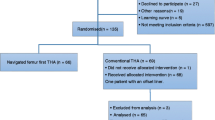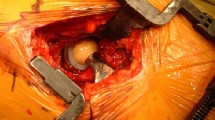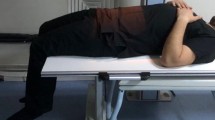Abstract
Purpose
Malposition of the acetabular component in total hip arthroplasty (THA) is a common surgical problem that can lead to hip dislocation, reduced range of motion and may result in early loosening. The aim of this study is to validate the accuracy and reproducibility of a single x-ray image based 2D/3D reconstruction technique in determining cup inclination and anteversion against two different computer tomography (CT)-based measurement techniques.
Methods
Cup anteversion and inclination of 20 patients after cementless primary THA was measured on standard antero-posterior (AP) radiographs with the help of the single x-ray 2D/3D reconstruction program and compared with two different 3D CT-based analyses [Ground Truth (GT) and MeVis (MV) reconstruction model].
Results
The measurements from the single x-ray 2D/3D reconstruction technique were strongly correlated with both types of CT image-processing protocols for both cup inclination [R²=0.69 (GT); R²=0.59 (MV)] and anteversion [R²=0.89 (GT); R²=0.80 (MV)].
Conclusions
The single x-ray image based 2D/3D reconstruction technique is a feasible method to assess cup position on postoperative x-rays. CT scans remain the golden standard for a more complex biomechanical evaluation when a lower tolerance limit (+/-2 degrees) is required.





Similar content being viewed by others
References
McCollum DE, Gray WJ (1990) Dislocation after total hip arthroplasty. Causes and prevention. Clin Orthop 261:159–170
Sarmiento A, Ebramzadeh E, Gogan WJ, McKellop HA (1990) Cup containment and orientation in cemented total hip arthroplasties. J Bone Joint Surg (Br) 72:996–1002
Lewinnek GE, Lewis JL, Tarr R et al (1978) Dislocations after total hip-replacement arthroplasties. J Bone Joint Surg Am 60:217–220
Patil S, Bergula A, Chen PC et al (2003) Polyethylene wear and acetabular component orientation. J Bone Joint Surg Am 85-A(Suppl 4):56–63
Widmer K-H (2007) Containment versus impingement: finding a compromise for cup placement in total hip arthroplasty. Int Orthop 31(Suppl 1):S29–S33. doi:10.1007/s00264-007-0429-3
Kalteis T, Handel M, Herold T et al (2006) Position of the acetabular cup—accuracy of radiographic calculation compared to CT-based measurement. Eur J Radiol 58:294–300. doi:10.1016/j.ejrad.2005.10.003
Marx A, von Knoch M, Pförtner J et al (2006) Misinterpretation of cup anteversion in total hip arthroplasty using planar radiography. Arch Orthop Trauma Surg 126:487–492. doi:10.1007/s00402-006-0163-0
Tannast M, Zheng G, Anderegg C et al (2005) Tilt and rotation correction of acetabular version on pelvic radiographs. Clin Orthop 438:182–190
Pradhan R (1999) Planar anteversion of the acetabular cup as determined from plain anteroposterior radiographs. J Bone Joint Surg (Br) 81:431–435
Widmer K-H (2004) A simplified method to determine acetabular cup anteversion from plain radiographs. J Arthroplasty 19:387–390
Della Valle CJ, Kaplan K, Jazrawi A et al (2004) Primary total hip arthroplasty with a flanged, cemented all-polyethylene acetabular component: evaluation at a minimum of 20 years. J Arthroplasty 19:23–26
Arai N, Nakamura S, Matsushita T, Suzuki S (2010) Minimal radiation dose computed tomography for measurement of cup orientation in total hip arthroplasty. J Arthroplasty 25:263–267. doi:10.1016/j.arth.2009.01.020
Seradge H, Nagle KR, Miller RJ (1982) Analysis of version in the acetabular cup. Clin Orthop 166:152–157
Zheng G (2010) Statistically deformable 2D/3D registration for estimating post-operative cup orientation from a single standard AP X-ray radiograph. Ann Biomed Eng 38:2910–2927. doi:10.1007/s10439-010-0060-0
Zheng G, von Recum J, Nolte L-P et al (2012) Validation of a statistical shape model-based 2D/3D reconstruction method for determination of cup orientation after THA. Int J Comput Assist Radiol Surg 7:225–231. doi:10.1007/s11548-011-0644-7
Murray DW (1993) The definition and measurement of acetabular orientation. J Bone Joint Surg (Br) 75:228–232
Nho J-H, Lee Y-K, Kim HJ et al (2012) Reliability and validity of measuring version of the acetabular component. J Bone Joint Surg (Br) 94-B:32–36. doi:10.1302/0301-620X.94B1.27621
Bland JM, Altman DG (1986) Statistical methods for assessing agreement between two methods of clinical measurement. Lancet 1:307–310
Bland JM, Altman DG (1996) Measurement error and correlation coefficients. BMJ 313:41–42
Lin F, Lim D, Wixson RL et al (2008) Validation of a computer navigation system and a CT method for determination of the orientation of implanted acetabular cup in total hip arthroplasty: a cadaver study. Clin Biomech Bristol Avon 23:1004–1011. doi:10.1016/j.clinbiomech.2008.04.015
Penney GP, Edwards PJ, Hipwell JH et al (2007) Postoperative calculation of acetabular cup position using 2-D-3-D registration. IEEE Trans Biomed Eng 54:1342–1348. doi:10.1109/TBME.2007.890737
Zheng G, Steppacher S, Zhang X, Tannast M (2007) Precise estimation of postoperative cup alignment from single standard X-ray radiograph with gonadal shielding. Med Image Comput Comput-Assist Interv 10:951–959
Zheng G, Zhang X (2010) Computer assisted determination of acetabular cup orientation using 2D-3D image registration. Int J Comput Assist Radiol Surg 5:437–447. doi:10.1007/s11548-010-0407-x
Steppacher SD, Tannast M, Zheng G et al (2009) Validation of a new method for determination of cup orientation in THA. J Orthop Res Off Publ Orthop Res Soc 27:1583–1588. doi:10.1002/jor.20929
Fujishiro T, Hayashi S, Kanzaki N et al (2014) Computed tomographic measurement of acetabular and femoral component version in total hip arthroplasty. Int Orthop. doi:10.1007/s00264-013-2264-z
Lu M, Zhou Y-X, Du H et al (2013) Reliability and validity of measuring acetabular component orientation by plain anteroposterior radiographs. Clin Orthop 471:2987–2994. doi:10.1007/s11999-013-3021-8
Acknowledgments
This work was partially supported by the Swiss National Science Foundation through the project NCCR-CO-ME.
Conflict of interest
The authors declare that they have no conflict of interest.
Author information
Authors and Affiliations
Corresponding author
Rights and permissions
About this article
Cite this article
Craiovan, B., Renkawitz, T., Weber, M. et al. Is the acetabular cup orientation after total hip arthroplasty on a two dimension or three dimension model accurate?. International Orthopaedics (SICOT) 38, 2009–2015 (2014). https://doi.org/10.1007/s00264-014-2336-8
Received:
Accepted:
Published:
Issue Date:
DOI: https://doi.org/10.1007/s00264-014-2336-8




